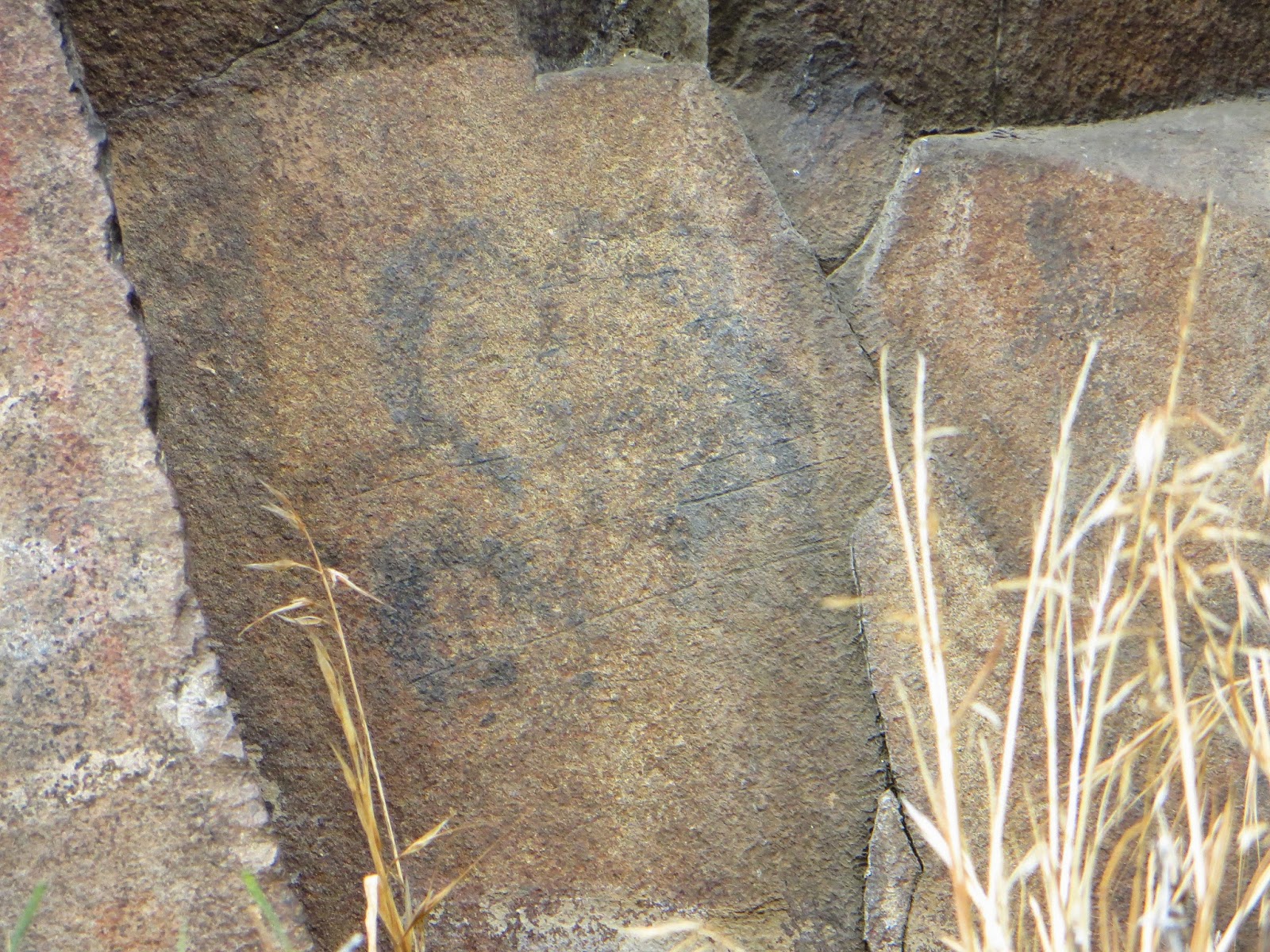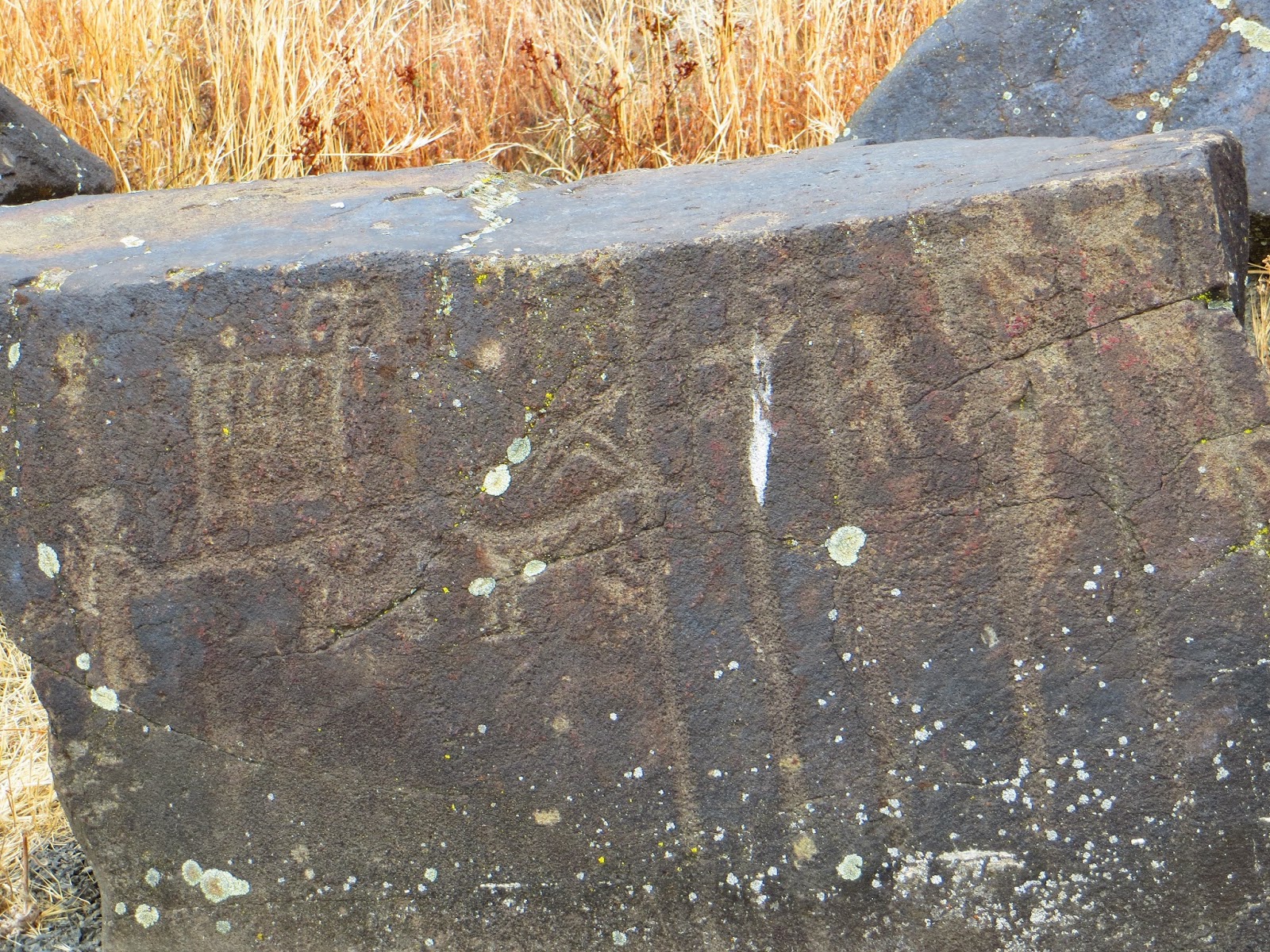 |
| Striated apple |
Cooling nights. Rain. Brightly hued leaves blaring a final trumpeting of color for the year. Apples. This is the time of harvest in Hood River county. Hoping for drier weather on the eastern side of "the line" we head for apple and pear land in the hill country south of Hood River. Winds buffet our car as wipers swipe the raindrops from the windshield. Large leaf maples splash brilliant gold swaths through the dark green fir and pine trees of the Columbia River Gorge. Towering basalt cliffs line the freeway on the south, a white-capped river rolls towards the ocean on the north and across the river a hundred-car train chugs its way east.
The
Vista House, with its familiar silhouette standing guard high above the freeway, is a landmark on the Old Columbia Highway. We'll save that for another day when the sky is clear. Passing by the famous
Multnomah Falls we see the surrounding trees there showing off their fall tints to the steady stream of visitors who stop to watch the cascading waters of Multnomah Creek free-fall 620 feet over the cliff. The bridge below the falls has been repaired to allow access to the trail taking hikers above the falls. On the Washington side,
Beacon Rock silently faces the weather in the Gorge, awaiting brave hikers who will scale its scaffold-enfolded western side to reach a view point at the top. Perhaps another time. We're on a mission to acquire apples today.
 |
| Young apple trees |
Entering Hood River we exit to connect with Highway 35, a roadway that heads south and eventually joins Highway 97 to Central Oregon, provides an encircling route around Mt. Hood and joins Highway 26 back into Gresham. But the fun of this route is the
Fruit Loop, an elongated loop that takes in most of the apple and pear orchards of the area, many of which have stores or stands where travelers can purchase fruit, cider, pear brandy, local wines and other treats and memorabilia associated with the fruits. Our destination is
Kiyokawa Family Orchards, a well-run operation with bins of apple and pear varieties lined up under cover at the store, a
fuzzless kiwi arbor loaded with clusters of purple fruit for the picking, a tasting tent housing over 100 varieties of heirloom and little-known apples and Asian pears, an open orchard for self-picking, a pumpkin collection and on a clear day, a view of snow-capped Mt. Hood.
 |
|
Parking our car alongside the orchard, we stroll the damp, grassy paths between endless rows of apple and pear trees. Varieties are marked at the ends of each row, fallen fruit lies in pools of gold, red and green at the base of trees and a lone picker for hire reaches deep into a tree for the premium fruit near the top. We marvel at the range of size and colors in the apple world: tiny crabapples with their extremely tart flavor, pink-fleshed apples with a hint of strawberry, striated Gravensteins and Galas, russets like Newton Pippin or Cox's Orange Pippin, the gigantic Hanner's Jumbo, weighing up to three pounds each, and Asian pears which are really a fruit of a different sort. All told, there are over 7500 apple varieties in the world!
 |
| Tasting tables |
Working our way around the tasting tables we sound much like other product connoisseurs in our mouth-smacking, mmmming, sniffing and commenting on each variety. Orchard personnel keep busy slicing thin pieces of each fruit onto plates where they are rapidly stabbed with toothpicks by eager tasters. Marking our tasting chart we compile a list of our favorites and head for the store. Most of these heirlooms have extremely limited availability so must be purchased directly from an orchard. The more plentiful apples and pears, along with fingerling red, white and blue potatoes, various squash, a few cases of very late peach varieties and the trendy but expensive honeycrisp apple are binned for public collection. Shoppers mill throughout the open-sided store, filling bags and boxes with their favorites while a specialty pizza trailer pumps delicious baking odors through the air. One featured pizza was topped with pepperoni, thin apple slices and feta cheese. Word had it that it was a winner!
 |
| Small size! |
Bagging my choices, I made for the cashier station to ransom my 60 pounds of apples. This was a light year as I still have pie filling and canned applesauce to consume. In years past I have been known to pick and process up to 300 pounds of apples. Slogging to my car through the increasing downpour I begin to dream of all the apple-centered dishes I would begin to make once home in my cozy kitchen. The journey home required battling with big rig splash-back, hydroplaning, gusty winds and torrential rain. A breather stop in Cascade Locks for a tall twisted cone calmed us down a bit and we were able to successfully finish our apple trek.
The easiest apple treat to make that doubled as dinner was a
Dutch Baby Pancake. It is baked in the oven and can be topped with sautéed cinnamon and sugar apple slices, a drizzle of honey or a squeeze of lemon juice and a dusting of powdered sugar. It is easy to make, fun to eat and opens the door to more comfort eating in this chilly, damp season of fall. Tomorrow will bring an
apple tarte tartin, perhaps apple cinnamon roll bread, apple slices with dried cranberries, feta cheese and honey-roasted sunflower seeds on a bed of greens. The applesauce can wait a bit. We'll dry apple slices tossed with cinnamon and sugar, eat fresh apples and gorgonzola cheese and dice apple pieces into microwaved oatmeal at breakfast time. Pie and crisp will follow next week and if I can find any space in my freezer, bags of pre-made pie filling will get stuffed in the gaps.
Take a run into apple country, buy a jug of cider, a bag of apples and enjoy the scenery. Loop around Mt. Hood for a day trip, stopping at one of the remote eateries on the way back into town. You'll make some great memories and bring home a little of Oregon's orchards.
 |
| Fuzzless kiwis |
 |
| Kiwi arbor |
 |
| Apple bins |
 |
| Pears and other produce |
 |
| Beautiful color and size |
 |
| Anna's Hanner's Jumbo |
 |
| Pears |
 |
| Fallen fruit |
 |
| Jonagolds |
 |
| Winter Bananas |
 |
| Queuing up |
 |
| Rain-dashed orchard aisle |
















































































































